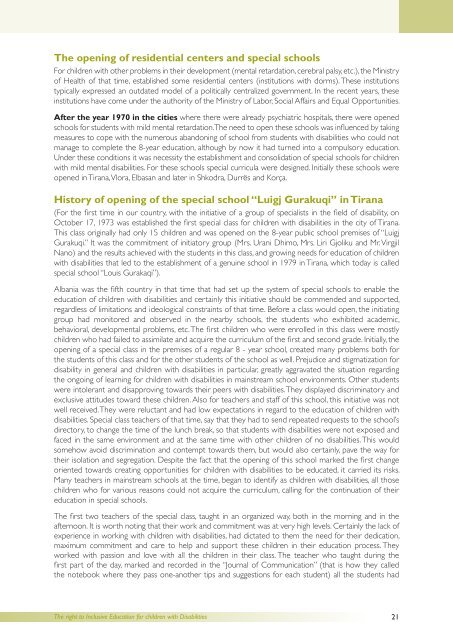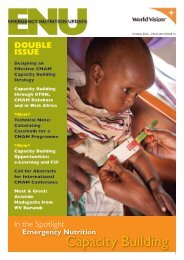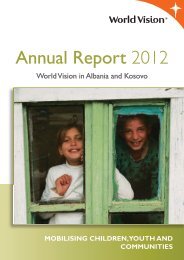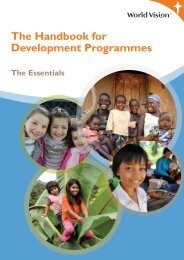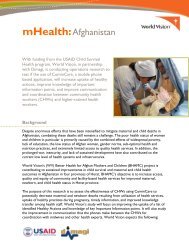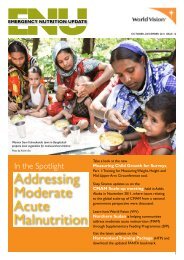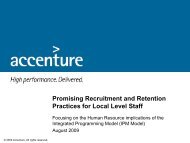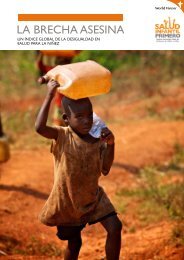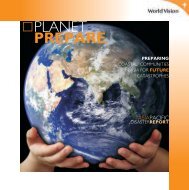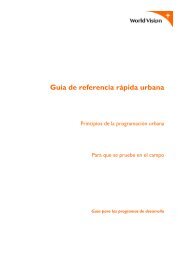the right to inclusive education for children with disabilities
the right to inclusive education for children with disabilities
the right to inclusive education for children with disabilities
Create successful ePaper yourself
Turn your PDF publications into a flip-book with our unique Google optimized e-Paper software.
The opening of residential centers and special schoolsFor <strong>children</strong> <strong>with</strong> o<strong>the</strong>r problems in <strong>the</strong>ir development (mental retardation, cerebral palsy, etc.), <strong>the</strong> Ministryof Health of that time, established some residential centers (institutions <strong>with</strong> dorms). These institutionstypically expressed an outdated model of a politically centralized government. In <strong>the</strong> recent years, <strong>the</strong>seinstitutions have come under <strong>the</strong> authority of <strong>the</strong> Ministry of Labor, Social Affairs and Equal Opportunities.after <strong>the</strong> year 1970 in <strong>the</strong> cities where <strong>the</strong>re were already psychiatric hospitals, <strong>the</strong>re were openedschools <strong>for</strong> students <strong>with</strong> mild mental retardation. The need <strong>to</strong> open <strong>the</strong>se schools was influenced by takingmeasures <strong>to</strong> cope <strong>with</strong> <strong>the</strong> numerous abandoning of school from students <strong>with</strong> <strong>disabilities</strong> who could notmanage <strong>to</strong> complete <strong>the</strong> 8-year <strong>education</strong>, although by now it had turned in<strong>to</strong> a compulsory <strong>education</strong>.Under <strong>the</strong>se conditions it was necessity <strong>the</strong> establishment and consolidation of special schools <strong>for</strong> <strong>children</strong><strong>with</strong> mild mental <strong>disabilities</strong>. For <strong>the</strong>se schools special curricula were designed. Initially <strong>the</strong>se schools wereopened in Tirana, Vlora, Elbasan and later in Shkodra, Durrës and Korça.his<strong>to</strong>ry of opening of <strong>the</strong> special school “luigj gurakuqi” in Tirana(For <strong>the</strong> first time in our country, <strong>with</strong> <strong>the</strong> initiative of a group of specialists in <strong>the</strong> field of disability, onOc<strong>to</strong>ber 17, 1973 was established <strong>the</strong> first special class <strong>for</strong> <strong>children</strong> <strong>with</strong> <strong>disabilities</strong> in <strong>the</strong> city of Tirana.This class originally had only 15 <strong>children</strong> and was opened on <strong>the</strong> 8-year public school premises of “LuigjGurakuqi.” It was <strong>the</strong> commitment of initia<strong>to</strong>ry group (Mrs. Urani Dhimo, Mrs. Liri Gjoliku and Mr. VirgjilNano) and <strong>the</strong> results achieved <strong>with</strong> <strong>the</strong> students in this class, and growing needs <strong>for</strong> <strong>education</strong> of <strong>children</strong><strong>with</strong> <strong>disabilities</strong> that led <strong>to</strong> <strong>the</strong> establishment of a genuine school in 1979 in Tirana, which <strong>to</strong>day is calledspecial school “Louis Gurakaqi”).Albania was <strong>the</strong> fifth country in that time that had set up <strong>the</strong> system of special schools <strong>to</strong> enable <strong>the</strong><strong>education</strong> of <strong>children</strong> <strong>with</strong> <strong>disabilities</strong> and certainly this initiative should be commended and supported,regardless of limitations and ideological constraints of that time. Be<strong>for</strong>e a class would open, <strong>the</strong> initiatinggroup had moni<strong>to</strong>red and observed in <strong>the</strong> nearby schools, <strong>the</strong> students who exhibited academic,behavioral, developmental problems, etc. The first <strong>children</strong> who were enrolled in this class were mostly<strong>children</strong> who had failed <strong>to</strong> assimilate and acquire <strong>the</strong> curriculum of <strong>the</strong> first and second grade. Initially, <strong>the</strong>opening of a special class in <strong>the</strong> premises of a regular 8 - year school, created many problems both <strong>for</strong><strong>the</strong> students of this class and <strong>for</strong> <strong>the</strong> o<strong>the</strong>r students of <strong>the</strong> school as well. Prejudice and stigmatization <strong>for</strong>disability in general and <strong>children</strong> <strong>with</strong> <strong>disabilities</strong> in particular, greatly aggravated <strong>the</strong> situation regarding<strong>the</strong> ongoing of learning <strong>for</strong> <strong>children</strong> <strong>with</strong> <strong>disabilities</strong> in mainstream school environments. O<strong>the</strong>r studentswere in<strong>to</strong>lerant and disapproving <strong>to</strong>wards <strong>the</strong>ir peers <strong>with</strong> <strong>disabilities</strong>. They displayed discrimina<strong>to</strong>ry andexclusive attitudes <strong>to</strong>ward <strong>the</strong>se <strong>children</strong>. Also <strong>for</strong> teachers and staff of this school, this initiative was notwell received. They were reluctant and had low expectations in regard <strong>to</strong> <strong>the</strong> <strong>education</strong> of <strong>children</strong> <strong>with</strong><strong>disabilities</strong>. Special class teachers of that time, say that <strong>the</strong>y had <strong>to</strong> send repeated requests <strong>to</strong> <strong>the</strong> school’sdirec<strong>to</strong>ry, <strong>to</strong> change <strong>the</strong> time of <strong>the</strong> lunch break, so that students <strong>with</strong> <strong>disabilities</strong> were not exposed andfaced in <strong>the</strong> same environment and at <strong>the</strong> same time <strong>with</strong> o<strong>the</strong>r <strong>children</strong> of no <strong>disabilities</strong>. This wouldsomehow avoid discrimination and contempt <strong>to</strong>wards <strong>the</strong>m, but would also certainly, pave <strong>the</strong> way <strong>for</strong><strong>the</strong>ir isolation and segregation. Despite <strong>the</strong> fact that <strong>the</strong> opening of this school marked <strong>the</strong> first changeoriented <strong>to</strong>wards creating opportunities <strong>for</strong> <strong>children</strong> <strong>with</strong> <strong>disabilities</strong> <strong>to</strong> be educated, it carried its risks.Many teachers in mainstream schools at <strong>the</strong> time, began <strong>to</strong> identify as <strong>children</strong> <strong>with</strong> <strong>disabilities</strong>, all those<strong>children</strong> who <strong>for</strong> various reasons could not acquire <strong>the</strong> curriculum, calling <strong>for</strong> <strong>the</strong> continuation of <strong>the</strong>ir<strong>education</strong> in special schools.The first two teachers of <strong>the</strong> special class, taught in an organized way, both in <strong>the</strong> morning and in <strong>the</strong>afternoon. It is worth noting that <strong>the</strong>ir work and commitment was at very high levels. Certainly <strong>the</strong> lack ofexperience in working <strong>with</strong> <strong>children</strong> <strong>with</strong> <strong>disabilities</strong>, had dictated <strong>to</strong> <strong>the</strong>m <strong>the</strong> need <strong>for</strong> <strong>the</strong>ir dedication,maximum commitment and care <strong>to</strong> help and support <strong>the</strong>se <strong>children</strong> in <strong>the</strong>ir <strong>education</strong> process. Theyworked <strong>with</strong> passion and love <strong>with</strong> all <strong>the</strong> <strong>children</strong> in <strong>the</strong>ir class. The teacher who taught during <strong>the</strong>first part of <strong>the</strong> day, marked and recorded in <strong>the</strong> “Journal of Communication” (that is how <strong>the</strong>y called<strong>the</strong> notebook where <strong>the</strong>y pass one-ano<strong>the</strong>r tips and suggestions <strong>for</strong> each student) all <strong>the</strong> students hadThe <strong>right</strong> <strong>to</strong> Inclusive Education <strong>for</strong> <strong>children</strong> <strong>with</strong> Disabilities21


